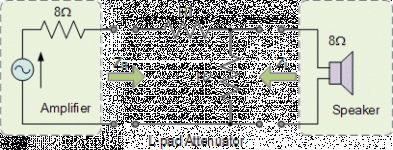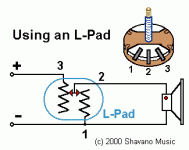Does the order of the series resistor and the drive unit in an l- pad ciruit matter?
I mean taken (for example) from the point of view of the "+" output terminal of the high pass output of the cross over, does it matter if the series reistor in an l-pad is before or after the drive unit.
My thinking is that it makes no difference as irrespective of the order of the resistor and the drive unit the Voltage across either individually remains the same for any given total voltage across both, irrespective of what "order" they are in.
NB: Obviously in both situations the shunt resistor is always parallel to the drive unit only.
I mean taken (for example) from the point of view of the "+" output terminal of the high pass output of the cross over, does it matter if the series reistor in an l-pad is before or after the drive unit.
My thinking is that it makes no difference as irrespective of the order of the resistor and the drive unit the Voltage across either individually remains the same for any given total voltage across both, irrespective of what "order" they are in.
NB: Obviously in both situations the shunt resistor is always parallel to the drive unit only.
The series resistor must be placed in front of the shunt resistor/driver parallel combination.
The reason for this is that the series resistance plus the resistance of the parallel combinination must equal the speaker impedance.
The reason for this is that the series resistance plus the resistance of the parallel combinination must equal the speaker impedance.
The whole purpose of a loudspeaker L-pad is to match the impedance of the source (amp or crossover network) to that of the load (the driver).My thinking is that it makes no difference as irrespective of the order of the resistor and the drive unit the Voltage across either individually remains the same for any given total voltage across both, irrespective of what "order" they are in.
The mathematics is actually quite difficult. To see it, scroll down to 'L-pad Attenuator with Equal Impedances' in this tutorial:
https://www.electronics-tutorials.ws/attenuators/l-pad-attenuator.html
Attachments
GezMoor is attempting to analyse the L-pad circuit in terms of voltages.
However, as giralfino has said, we need GezMoor to illustrate what he means by "does it matter if the series resistor in an l-pad is before or after the drive unit.
However, as giralfino has said, we need GezMoor to illustrate what he means by "does it matter if the series resistor in an l-pad is before or after the drive unit.
I believe the question is can the series resistor be placed on the "-" wire instead of the "+" wire. The answer to that question is yes.
Hey there,
I think you have great answers, but what I encourage you to do is grab XSim and try out all your combinations yourself. It will help you see how your choices affect the overall results.
Best,
Erik
I think you have great answers, but what I encourage you to do is grab XSim and try out all your combinations yourself. It will help you see how your choices affect the overall results.
Best,
Erik
As simple as that? Blimey!I believe the question is can the series resistor be placed on the "-" wire instead of the "+" wire. The answer to that question is yes.
I believe the question is can the series resistor be placed on the "-" wire instead of the "+" wire. The answer to that question is yes.
Yes that's exactly what i meant, sorry i wasn't clear.
The whole purpose of a loudspeaker L-pad is to match the impedance of the source (amp or crossover network) to that of the load (the driver).
The mathematics is actually quite difficult. To see it, scroll down to 'L-pad Attenuator with Equal Impedances' in this tutorial:
https://www.electronics-tutorials.ws/attenuators/l-pad-attenuator.html
So in your attachment i'm asking if it would make any difference if R1 was on the bottom wire rather than the top wire, but still "between" the source and the shunt resistor.
That would be just like turning the attachment upside down - it makes no difference to the circuit's operation.
i'm asking if it would make any difference if R1 was on the bottom wire rather than
the top wire, but still "between" the source and the shunt resistor.
Either circuit branch has same current, so there's no difference. That's just rearranging two
things that are in series.
Last edited:
That would be just like turning the attachment upside down - it makes no difference to the circuit's operation.
Either circuit branch has same current, so there's no difference. That's just rearranging two
things that are in series.
Great thanks, that's what i thought.
- Home
- Loudspeakers
- Multi-Way
- Tweeter L-Pad - component order

